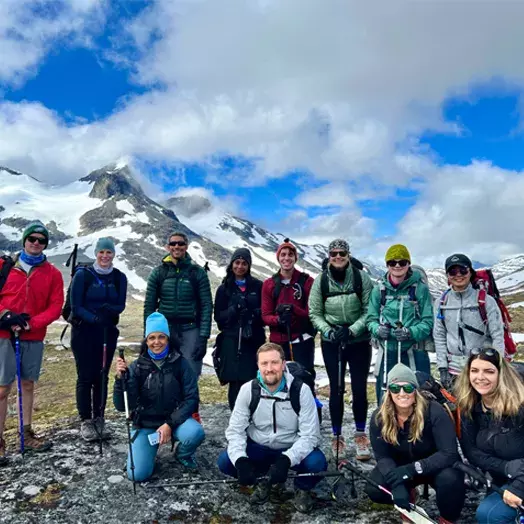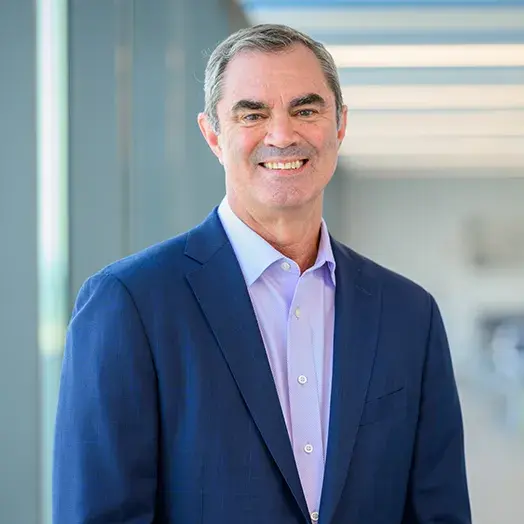
Carey Business School students trek through Norway to grow leadership skills
This past summer, 17 Flexible MBA students trekked through Norway for nine days. While this may sound like a vacation, it was much more than just backpacking through mountains and waterfalls.
As America’s first research university, Johns Hopkins University is no stranger to taking the classroom to the field for hands-on learning. In July, the Johns Hopkins Carey Business School group ventured through the mountains of Scandinavia not to enjoy the scenery but to expose themselves to new, and often uncomfortable, leadership challenges.
The trip was a Leadership Development Expedition, one of a variety of experiential learning opportunities offered by Carey Business School’s Center for Innovative Leadership. The idea is that students participate in faculty-led adventure expeditions across the world to build their own leadership skills through hands-on experiences leading and working with a team of peers in a challenging wilderness environment.
“The courses are centered around the idea of individual leader development,” said Christopher Myers, PhD, associate professor of Management and Organization and the founding faculty director of the Center for Innovative Leadership. “These experiences are designed to be slightly unfamiliar so that students get the chance to be in a complex situation and work with others to problem-solve on several different issues. It’s a place to try new and different approaches to leading in the face of challenge.”
The expeditions, offered to Carey’s full- and part-time MBA students, start with an application. Once accepted, students go through a reflective process to develop goals around understanding their current leadership skills and areas they would like to improve.
The Leadership Development Expeditions were created and are led by Myers and Mike Doyle, the Center for Innovative Leadership’s executive director and Carey Business School adjunct faculty member.
Doyle and Myers each worked as adventure leadership guides early in their careers. They have experience leading teams and student groups in challenging environments that provide learning opportunities for leadership and teamwork.
“We knew this type of experiential learning would be a good fit for Carey because the university is an innovative business school with opportunities to experiment in different areas,” said Doyle.
And it’s proven to be as effective as both Doyle and Myers anticipated.
“One of the reasons I chose Carey’s Flexible MBA program was for the experiential learning opportunities,” said Iris Kao (Flexible MBA ’23), senior manager of commercialization at Illumina. “The Norway trip allowed me to build relationships with my classmates. Many of them are leaders in different industries, so I was able to learn different leadership approaches throughout the experience.”
Trekking through Norway
As part of the nine-day trek, students can take on the role of “leader of the day.” The leader supports the team by making strategic decisions about various navigational, logistic, and environmental challenges facing the team that day and collaborating with peers to provide constructive leadership. At the end of each day, students receive peer-to-peer feedback, which provides new insights on their strengths and weaknesses as they led the team.
“The experience was humbling,” said Kao. “I was able to understand how to leverage my strengths to continue to grow as a leader while also being held accountable by my peer feedback partner who gave advice on how I could evolve my motivation and influencing skills.”
The nightly debriefing meeting allows students to turn the feedback directly into action items and learning goals, helping them transfer the skills back to the companies where they work so they become more effective and thoughtful leaders.
“The personal growth I experienced on the expedition has translated directly to my current role,” said Pete Tomczak (Flexible MBA ’22), senior manager of strategy and corporate development at CONMED Corporation. “I’m more aware of how I listen and communicate so that I can build the trust to influence without authority. I’m now comfortable leading up, down, or laterally in my organization.”
“We knew this type of experiential learning would be a good fit for Carey because the university is an innovative business school with opportunities to experiment in different areas."
Mike Doyle, Executive Director, Center for Innovative Leadership
Leading with agility, empathy, and competence
A key component of the nine-day experience is for students to focus solely on themselves, their team, and their leadership.
“The experience requires students to disconnect from their everyday lives and immerse in an impactful learning environment,” said Doyle. “When they arrive in Norway, they have an opportunity to experiment with what they do well, but also with what they can improve.”
Doyle and Myers focus students’ reflection and experimentation around three dimensions of effective leadership, encouraging students to think about how they can appropriately be agile, empathetic, and competent when leading.
“This leads back to the model that underpins the CIL: Leadership is responding to a particular situation with the right level and combination of empathy, competence, and agility to meet the needs of a specific moment or challenge,” said Myers.
Doyle and Myers say they flex their own leadership behaviors throughout the course as well, modeling the practice they hope students adopt. Their goal is to let students manage and lead themselves over the course of the expedition. But if circumstances change – for example, the weather turns dangerous – they step back in and engage in more directive leadership.
“On the second day of our trek, we woke up to extreme weather,” said Kristen Reeves, a Flexible MBA student and senior project manager at NASA/KBR. “We began hiking, but the weather became worse. I gathered with my co-leaders, professor, and guide to discuss the weather and safety of our group, and the decision was made to turn around. As leaders of the day, we knew it was the right decision. I remember thinking back to our pre-trek course, ‘What does this moment ask of me as a leader?’ We not only learned how to lead, but how to lead depending on what the moment asked of us.”
Every year brief situations – like weather – pull Doyle and Myers temporarily back into a more hands-on leadership position within the group. And they use the situation as a learning experience. “These situations are going to happen in their own organizations, so connecting this real-life experience is a great teachable moment,” Doyle said. “These are examples of flexibility and agility that come to life, so students can then take them directly back to their organization.”
The Center for Innovative Leadership (CIL) at the Carey Business School aims to advance knowledge and build capacity for innovative leadership in modern organizations. The CIL is a hub for new ideas and insights on leadership, combining faculty-led research, student-facing programming, and community-focused impact.


